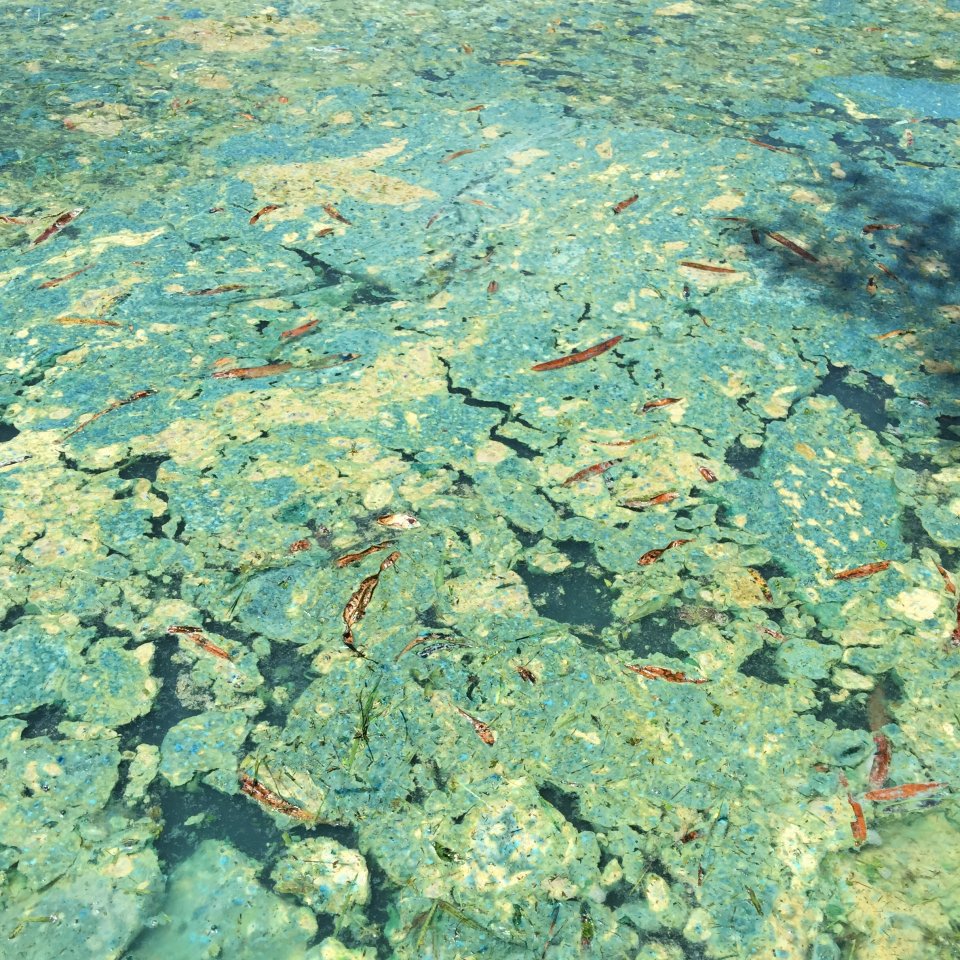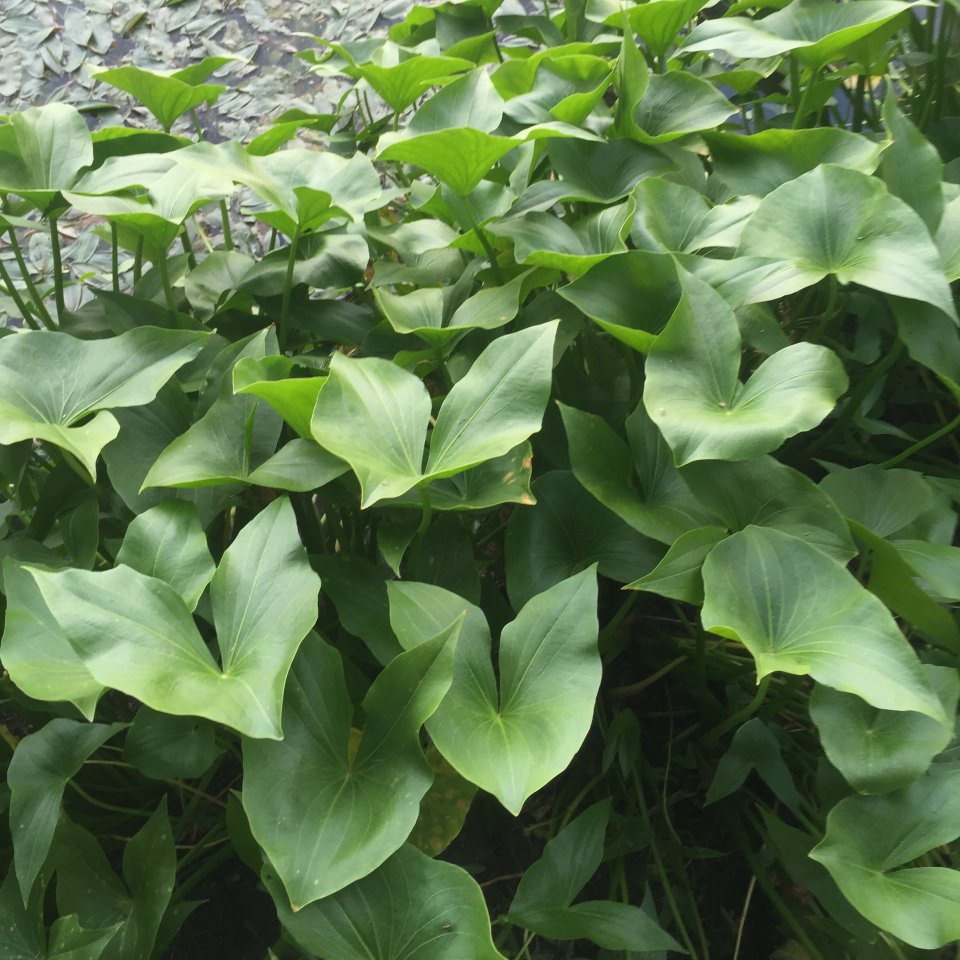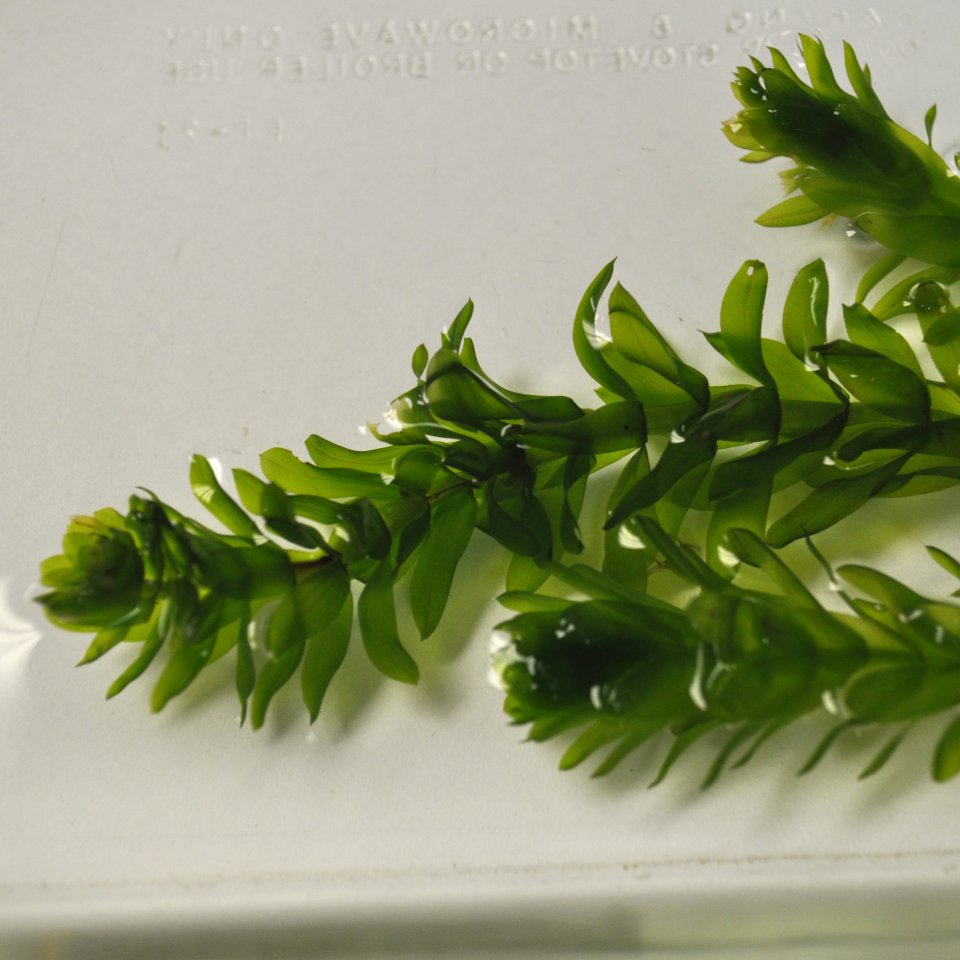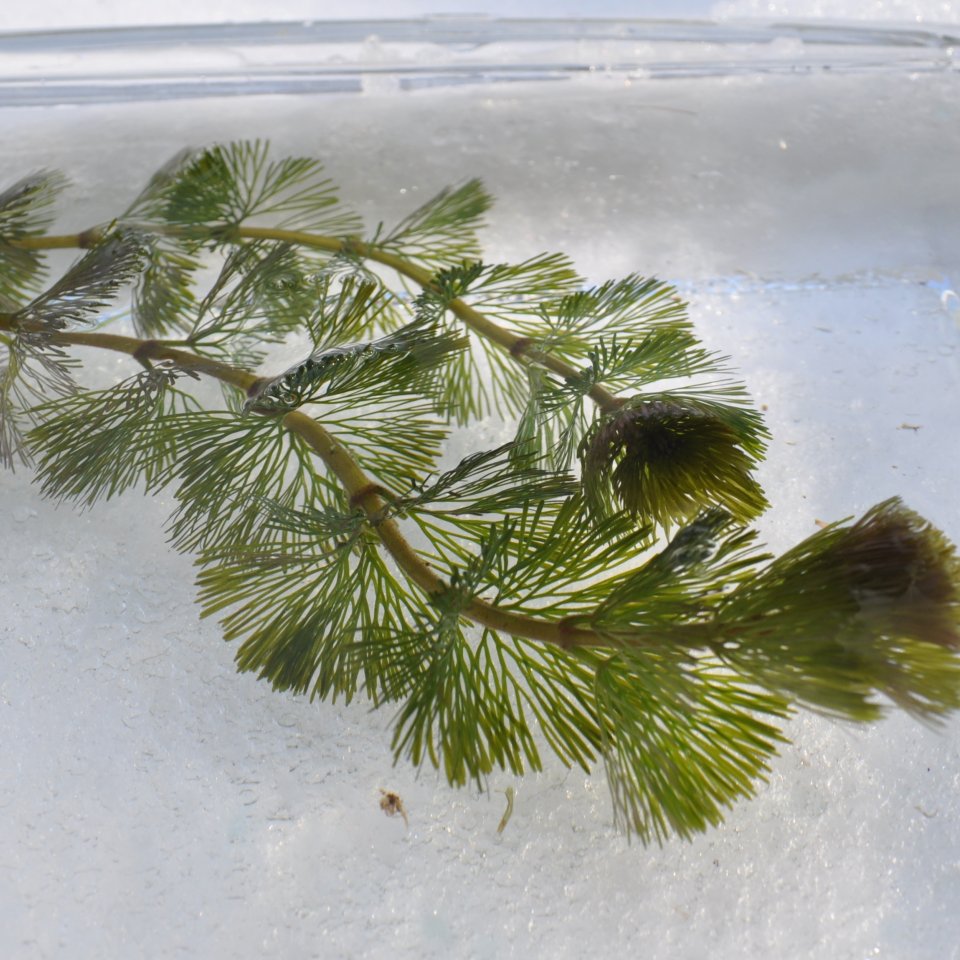
Aquatic Weed ID Guide
Questions? Email us: WeedID@joneslakemanagement.com
American Pondweed
American pondweed has floating, sword shaped leaves. This plant can be easily identified in ponds where its floating leaves form a mat on the surface. It is best controlled in the early stage of development before the formation of a nutlet and subsequent seed dispersal.

Anabaena
Often observed as blue or green in color, this cyanobacteria has been linked to human and animal illnesses, often resulting in vomiting, diarrhea and abdominal pain.

Arrowhead
Arrowhead is a perennial plant that is often found around the edges of a pond in dense stands. Arrow-shaped leaves stand 2-3 feet tall. White blooms will often be observed in late summer. Strong roots allow this plant to survive fluctuating water levels and weather conditions.

Azolla Fern
Azolla fern forms a dense mat on the water surface. Each plant dangles thread-like roots into the water. Under certain conditions, azolla fern turns a reddish-brown color. With the ability to double its concentration in 7 days, this plant is extremely invasive.

Bladderwort
Bladderwort is a free-floating plant with no visible roots. It has finely divided leaves and gets its name from the small, bladder-like structures located on the leaves. These ""bladders"" are used by the plant to capture and consume aquatic invertebrates.

Brazilian Elodea
Often referred to as anacharis, Brazilian elodea has leaves arranged in whorls of 4-6. It is bright green in color with a relatively smooth leaf edge and produces a small, white flower.

Brittle Naiad
Brittle naiad is often found growing in clumps and can be identified by its bushy appearance under water. The long, pointed leaves have distinct spines and are oppositely arranged on the stem. The entire plant is brittle and breaks easily.

Bulrush
Bulrush is a native, wetland sedge that grows 2-4 feet high. With the potential to form dense stands, bulrush can be used to control shoreline erosion and create aquatic habitat. The unbranched stem often terminates into tight clusters of flowers and seeds.

Cabomba
Cabomba has submersed, fan-shaped leaves oppositely arranged on the stem. Each leaf is dissected into narrow segments with undissected leaves present on the surface. The flower is white to light yellow in color.

Chara Algae
This advanced form of algae is frequently mistaken for a true aquatic weed. Chara is best identified by its musky odor and gritty textures as a result of surface calcium deposits. Dense growths attach, but do not root, and may cover the entire lake bottom.

Clasping-leaf Pondweed
Clasping-leaf pondweed has a wide, wavy leaf with a broad base that extends three-quarters of the way around the stem of the plant. The leaves are alternatively arranged on the stem, with the upper stem appearing branched and leafy.

Common Cattail
Cattails inhabit wet lowland areas and pond perimeters with the ability to grow in as much as 4 feet of water. The long, slender, grass-like stalks can reach 10 feet in height with mature plants producing a catkin in mid-summer.

Common Reed
Common Reed is a large, invasive perennial grass found in wetlands throughout most of North America. It can reach 15 feet in height and forms dense stands capable of outcompeting native plants due to its invasive nature.

Coontail
Usually found in hard water, coontail is found completely submerged but lacks roots. The dark green forking leaves are arranged in whorls on the stem. Coontail can be found throughout the continental United States. It is difficult to control and may require several herbicide applications.

Creeping Water Primrose
Found in shallow water or moist soils, creeping water primrose has a hollow red stem with numerous green and red leaves. A bright, yellow flower will often distinguish it from similar weeds.

Curly-leaf Pondweed
Curly-leaf pondweed leaves are green with a reddish hue. The wavy margins on the sides of its leaves make this plant easy to identify. Curly-leaf pondweed thrives in the early spring before most pond weeds are prevalent.

Duckweed
This small floating green plant has a 1-2 inch thread-like root and is often mistaken for algae. It is most commonly seen in older, nutrient-rich ponds. Duckweed is notorious for covering the entire pond surface and may induce a fish kill by not allowing sunlight to penetrate the water.

Eelgrass
Eelgrass has ribbon-like, flaccid leaves. Each plant has a horizontal stem system connecting tufts of leaves and blooms in late summer. Eelgrass often grows to the surface where it impedes recreational activities, such as boating and swimming.

Euglena
Euglena are unicellular organisms that inhabit nutrient-rich ponds and lakes, often turning the water a reddish-brown color. The severity and occurrence of red cyanobacterial blooms are limited by phosphorus availability in the water column.

Eurasian Watermilfoil
Eurasian watermilfoil is one of the most aggressive and problematic aquatic weeds to infest ponds and lakes. Stems are reddish in color with fan shaped leaves. This plant spreads easily through fragmentation.

Filamentous Algae
Commonly referred to as pond scum or moss, filamentous algae forms mats on the water surface. This algae usually begins its growth along the edges or pond bottom and mushrooms to the surface, buoyed by the oxygen it has produced during photosynthesis.

Floating Heart
Floating heart produces yellow flowers that stand 1-3 inches above the surface of the pond. The foliage is slightly variegated resembling a typical, but small, water lily leaf. It has the ability to spread throughout the pond via its extensive root system.

Hydrilla
Hydrilla has leaves with toothed margins and a toothed mid-rib. The leaves are arranged in whorls of 4-8. Hydrilla is a major problem throughout much of the United States, because it is difficult to control and its tubers are winter hardy.

Lotus
Lotus is a winter hardy plant that thrives in sunny, shallow locations. Given the right conditions, it will grow extremely quickly and can become a nuisance. Lotus foliage and blooms will stand 3-5 feet above the water. This plant is easiest to control in the summer months.

Microcystis
Often referred to as a slick or film, microcystis is a colonial variety of cyanobacteria. Buoyant cells accumulate along shores in windward direction. Microcystis is commonly found in nutrient-rich ponds in mid to late summer. Contact with microcystis blooms may cause skin irritation and gastrointestinal distress. Avoiding contact is advisable.

Oscillatoria
This troublesome variety of cyanobacteria forms small spongy masses that grow on the bottom and eventually float to the surface. It often has a dull gray color and is difficult to control.

Parrotfeather
Parrotfeather is an immersed plant often seen trailing along the pond edge. The leaves are deeply cut and feathery-looking, bright blue-green in color and arranged in whorls of 4-6 around the stem.

Purple Loosestrife
Bright purple-hued flowers are terminally located on a 4-sided stem. Leaves are usually found in pairs and arranged oppositely on the stem. It is best to control this invasive species before it sets seed. Plants may reach 6-7 feet in height.

Sago Pondweed
Sago Pondweed has a busy appearance with narrow, thread-like leaves arranged alternately on the stem. Like other pondweed varieties, sago pondweed is a valuable food source for waterfowl.

Scouring Rush
Scouring Rush is an ancient horsetail variety that gets its name from the silica in its cells. The silica, which gives the plant a rough texture, has been used to scrub cooking pots and polish metal. The silica reduces herbicide penetration and makes the scouring rush difficult to control.

Small Pondweed
Small Pondweed is a perennial, submersed aquatic weed. Slender, ribbon-like leaves alternate on the thin stems. Common along shorelines in depths up to 8 feet, small pondweed forms dense clumps that may impede fishing and other recreational activities.

Southern Naiad
Southern naiad is a leafy plant with wider leaves at the base. The leaves are arranged oppositely or in whorls of three around the plant stem. The leaf margins contain visible spines, while the leaf axis often conceals a tiny seed. This plant frequently grows in thick beds that make control difficult.

Spatterdock
Spatterdock is a large, water lily-like plant with floating and immersed, heart-shaped leaves. The round, yellow flowers are smaller than golf balls. Spatterdock can spread by both seeds and its large spongy rhizomes. Control often requires multiple herbicide treatments.

Spearwort
Spearwort can be identified by its shiny, yellow flowers with egg-shaped petals on reddish-green stalks. The plant can grow anywhere from 4-48” in height, with few shoots growing from the stem. Spearwort is usually found in marshy areas.

Spike Rush
Spike Rush is comprised of green, leafless stems which vary in length from 5 inches to 4 feet. Plants grow in clumps and are tipped with brown spikelets. The are normally found along the shoreline or in shallow water.

Swamp Iris
This plant is one of the first of the spring to exhibit its magnificent yellow flowers. The bright, vibrant flowers extend up above the sword-shaped leaves and continue to bloom throughout May.

Variable-leaf Pondweed
Variable-leaf pondweed is a perennial plant comprised of two kinds of leaves. The floating leaves are ""leathery"" and oval in shape, while the submerged leaves are thin and longer than the floating leaves.

Water Clover
Also known as European Water Clover, this plant is an aquatic invasive species most likely introduced to the United States through the aquarium industry. It can be found in shallow waters with muddy or sandy bottoms either resting on the water’s surface or standing just above.

Water Lettuce
Water lettuce is a floating plant that grows in ponds, lakes, canals and rivers where it forms large, dense mats. Its rapid reproduction rate may impede recreational activities, such as boating or fishing. Water lettuce will not survive the winter in areas that experience freezing temperatures.

Water Lily
Water lilies are often intentionally planted for fish habitat or aesthetics. Water lilies spread very quickly due to their elaborate root system. Each stem produces a round leaf 6-12 inches in diameter. Leaves are usually green with reddish-purple undersides.

Water Mint
Water Mint is a perennial plant found growing in moist soils or shallow waters and easily identified by its minty fragrance. The leaves are typically dark green. In mid-summer, the plant will produce a pink or lilac colored flower.

Water Shield
Water shield has floating, oval leaves that resemble small water lilies. These leaves rarely exceed 4.5 inches and exhibit no slit. Water shield has a very distinctive mucus-like, or gelatinous, coating on stems and new growth tips. Often found in acidic waters, water shield provides excellent habitat for fish and waterfowl.

Water-net Algae
Hydrodictyon is a type of filamentous algae characterized by a hollow, tube-like structure. Upon closer examination, these tubes appear to be comprised of a hexagonal netting. Fragmentation and rapid growth in nutrient-rich water allow this algae to quickly overtake a pond.

Watermeal
Watermeal is a small granular plant that lacks roots. It thrives in still, nutrient-rich conditions and may be seen alone or growing with duckweed.

Willow Tree
Willow trees are deciduous, medium sized trees that are often used to stabilize pond shorelines. However, if left unmanaged, willows can spread rapidly and prevent access to the water. Larger specimens may have to be cut before an herbicide can be applied.



